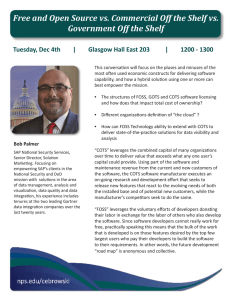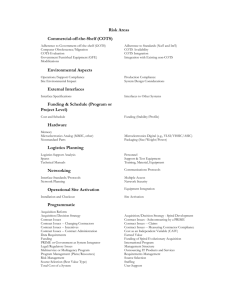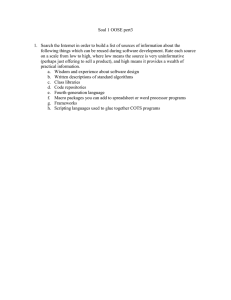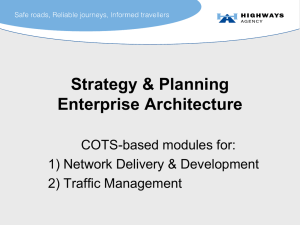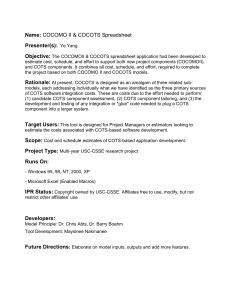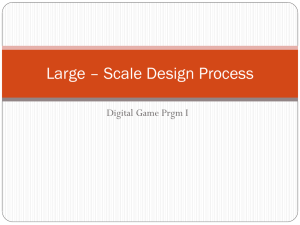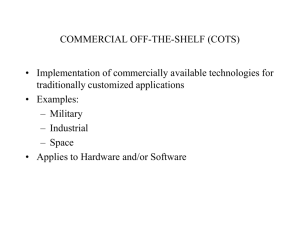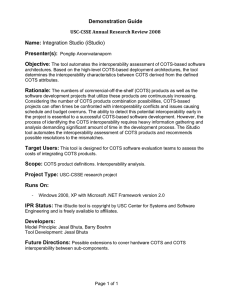Assessing the Risks of Commercial-Off-The Shelf Applications
advertisement
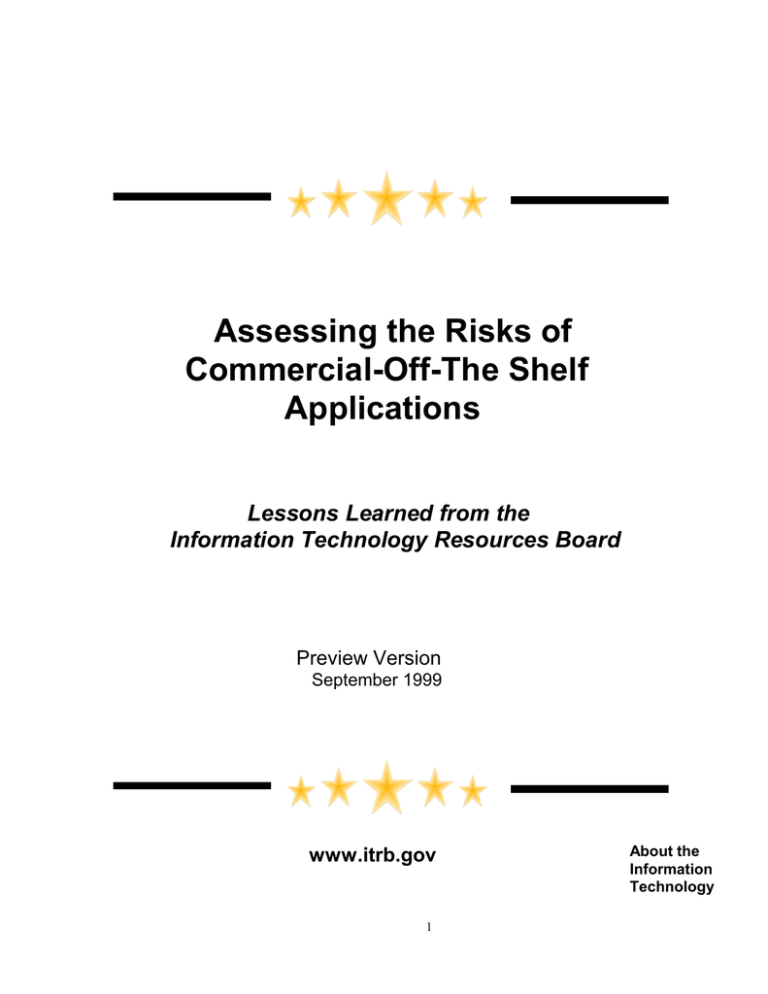
Assessing the Risks of Commercial-Off-The Shelf Applications Lessons Learned from the Information Technology Resources Board Preview Version September 1999 www.itrb.gov 1 About the Information Technology Resources Board (ITRB) Pursuant to the Government Performance and Results Act of 1993, Paperwork Reduction Act of 1995, and Information Technology Management Reform Act of 1996, the ITRB was established in July 1996 by Executive Order 13011. Some of the goals of this Executive Order were to: Create a support structure that builds on existing successful interagency efforts to provide expertise and advice to agencies; Improve the management and use of IT within and among agencies by identifying and sharing experiences, ideas, and promising practices; and Provide innovative, multi-disciplinary, project-specific support to agencies to enhance interoperability, minimize unnecessary duplication of effort, and capitalize on agency successes. In concert with these goals, the ITRB has two primary objectives. The Board conducts confidential assessments of mission critical information system projects at the request of client agencies. In addition, based upon their own experiences and insights gleaned from their assessments, the ITRB shares information across all levels of government in the form of publicly available guides. To date, these guides are: Project Management for Mission Critical Systems Practical Strategies for Managing Information Systems The Diminishing Pool of Skilled Information Technology Executives: IT Brain Drain; and Managing Information Systems: A Practical Assessment Tool. Board members are executives and experienced practitioners from Federal agencies who bring diverse program, technical, and acquisition management expertise to managing and developing major information systems. Ultimately, the ITRB’s activities advance measurable improvements in mission performance and service delivery through the strategic application of information technology. 2 Current ITRB Members Valerie Wallick, Chair Mary Ellen Condon Sandra Borden Kevin Carroll Kay Clarey Wayne Claybaugh Mark Day Joanne Ellis George Hyder Ken Heitkamp Skip Kemerer Mike Laughon Jean Lilly Eric Mandel Emory Miller Department of the Navy Department of Justice United States Coast Guard Department of the Army Department of the Treasury Social Security Administration Environmental Protection Agency Department of Agriculture Office of Personnel Management Department of the Air Force Nuclear Regulatory Commission Department of the Interior Internal Revenue Service Department of Commerce General Services Administration ITRB Management Staff Sandra Hense Ginni Schaeffer Jake Asma Avis Ryan General Services Administration General Services Administration General Services Administration General Services Administration 3 CONTENTS Introduction . . . . . . . . . . . . . . . . . . . . . . . . . . . . . . . . . . . .1 Risk Profile. . . . . . . . . . . . . . . . . . . . . . . . . . . . . . . . . . . . .4 Assessing Results . . . . . . . . . . . . . . . . . . . . . . . . . . 4 Business Purpose . . . . . . . . . . . . . . . . . . . . . . . . . . 6 Organization . . . . . . . . . . . . . . . . . . . . . . . . . . . . . . 8 Technology . . . . . . . . . . . . . . . . . . . . . . . . . . . . . . 10 Acquisition . . . . . . . . . . . . . . . . . . . . . . . . . . . . . . .13 Implementation . . . . . . . . . . . . . . . . . . . . . . . . . . . 16 Tools for the Toolkit . . . . . . . . . . . . . . . . . . . . . . . . . . . 18 4 Introduction Increasingly, Federal agencies are turning to a Commercial Off the Shelf (COTS) application package solution for requirements that previously were met by in-house or contractor software development projects. This shift to COTS solutions is driven by several factors, including the: inability of software developers to complete projects on time, or within or under budget, growing availability of COTS packages for business and administrative functions, allure of enterprise-wide solutions, and volume of articles in the trade press that have declared COTS solutions as more cost effective than developed software. Caveat emptor. The majority of COTS solutions require extensive customization to meet the needs and support the business processes of the Federal environment. Federal agencies must make major business process reengineering changes to use COTS solutions as delivered. Often, COTS packages provide only a partial solution and require an interface to an existing system. The interface may be simple or difficult to implement, but usually requires personnel resources to resolve subsequent problems. The Information Technology Resources Board (ITRB) believes that the availability of appropriate guidelines and information gleaned from case examples will promote a greater awareness and better informed decisions when considering a COTS solution. This in turn, will lead to more successful COTS implementations in the Federal environment and ideally, result in better service to the American public. So, the ITRB has developed this tool to assist Federal organizations in clarifying the myriad risks their organization will encounter when facing a COTS implementation. We also recognize the value of sharing practical, proven experiences. To supplement the Risk Profile, the ITRB offers the following 'lessons learned" distilled from our extensive experience in developing, acquiring, and managing information systems for the Federal government: Understand the COTS product—Early in the process, obtain a comprehensive understanding of the functionality of the COTS package. If possible, obtain hands-on experience with the system. Consider prototyping or piloting the package in your environment. At a minimum, visit another organization that is operating the same software. 1 Examine the "gap"—Because no COTS product has been specifically designed to meet your organization's unique requirements, there will be a gap between the business processes supported by your existing systems and those supported by the COTS package. It is imperative that you understand this gap well before the implementation begins and ensure your organization can accept this gap without degrading performance. Incorporate lessons learned—One of the benefits of using a COTS product is that other organizations have undergone a similar implementation process. Be sure to actively solicit and rigorously incorporate into your own plans those lessons learned from organizations similar to yours. Secure required resources—Acclimating an organization to the new business processes supported by a COTS product takes time and resources. Be sure, before the implementation begins, that your organization has the time and financial and personnel resources necessary to support it during the acclimation period. It is also important that your team contains the appropriate "balance" of technical and functional experts and (if possible) is experienced in the implementation of the considered COTS product. Involve functional users—Because the implementation of a COTS product could significantly impact the business functions of an organization, it is imperative to involve the user community in the planning process from the outset. In addition to the technical issues, understanding the business issues will lower the risks associated with the COTS implementation. A stable operating environment coupled with functional users willing to accept a new way of doing business will also minimize implementation obstacles. Validate performance and scalability—Confirm, with other users, the product's capabilities, especially performance and scalability. Also ensure that the product's capabilities support the needs of your organization. For instance, confirm that the product has previously supported the number of users and geographic locations your organization will require. Test the COTS product in your operating environment to ensure compatibility. 2 Select mature products—An implementation involving a COTS product with a successful track record is less risky than one that involves new, unproven capabilities. It is therefore crucial to utilize mature, "road-tested" COTS products. Ensure that a reputable and reliable vendor is and plans to be available to support the product. Fully understand contractual conditions— Understand completely, the details associated with the product contract, including the licensing agreement. Be sure to find out: who owns the license to the source code; what rights are provided relative to source code modification; and what arrangements will exist at contract expiration. Validate that the agreement sufficiently meets your organization's needs. For example, if everyone in the organization will need to access the product, ensure the license is for the entire enterprise. It has also been proven that a mutually beneficial relationship between the government and the vendor will allow the government to drive or benefit from enhancements to the COTS product. The Risk Profile offered here incorporates some of the most significant lessons learned from a variety of COTS implementations to help you evaluate risk in your own organization. 3 Risk Profile This Risk Profile is organized around five broad categories: business purpose, organization, technology, acquisition, and implementation. Each category, which represents critical aspects required for the successful implementation of a COTS application package(s), is defined below: Business Purpose: The business requirements driving the organization to consider a COTS solution and the “fit” of those requirements with available COTS application package(s). Organization: The existing organizational factors that determine the appropriateness of a specific COTS solution including - but not limited to - location(s), infrastructure, and staff experience. Technology: The technical “fit” of the COTS product(s) with the existing and planned technical architecture, which supports an organization. This includes the organization’s inherent technical challenges, such as the number and complexity of interfaces and performance requirements. Acquisition: The key considerations for developing and executing a successful acquisition strategy, including type of contract and vendor past performance. Implementation: The process that drives the delivery of a COTS solution within an organization that includes - but is not limited to - cost, schedule, testing, and managing organizational change. NOTE: Within each category, Risk Profile questions about COTS software refer to COTS application package(s) and COTS product(s), synonymously. Assessing Results Risk Profile questions are organized around the five broad areas of implementing a COTS solution as presented above. Each question prompts you, the respondent, to think about key factors for a successful COTS application package implementation. You should carefully consider your answer in terms of how it pertains to projects within your own organization. Completing the questions and assessing results will help you to better understand the overall level of risk associated with 4 implementing a COTS application package(s) given current business needs and organizational conditions. In turn, this knowledge will help guide you to take the steps necessary to minimize specific risks associated with the implementation of a COTS product(s). Your profile may also be particularly useful in formulating a strategy for acquiring a COTS product(s). Answers to each question are provided by the choice a, b or c, which correlate to the three levels of risk: low, medium and high, respectively. A box is provided for adding the total number of a, b, or c responses for each section. If most of your responses were a's, your organization has a low risk profile for successfully implementing a COTS application package(s). While an overall profile of low risk is a strong indicator, it is important to note that this profile does not mean a "no-risk" profile. Every COTS product(s) implementation involves some degree of risk. If most of your responses were b's, your organization has a moderate risk for implementing a COTS application product(s). Carefully examine the questions, particularly with medium risk (b) and high risk (c) responses to identify specific vulnerabilities. If most of your responses were c's, your organization has a high degree of risk for implementing a COTS product(s). Review the questions to help your organization identify critical areas that need to be reexamined regardless of its COTS implementation phase. Many organizations who attempt to implement a COTS application package(s) without sufficient analysis and preparation encounter significant challenges that can be related to the business processes used to build systems, technologies used to construct the system, and organizational change management issues that inevitably arise. Careful consideration of these issues will help to minimize your organization's Risk Profile and curb future expenditures. With any level of risk, awareness of lessons learned by other organizations that have implemented a COTS application package(s) will help build or strengthen strategies to address any unexpected challenges that may arise. 5 Business Purpose 1. How well are your organization's business requirements documented? a. Thoroughly—comprehensive, current documentation exists b. Moderately well—comprehensive documentation exists, but has not been updated recently c. Poorly—minimal documentation exists 2. What priority does the COTS application package(s) implementation represent in the organization? a. High—for example, included in business plan b. Medium c. Low 3. Because specific business processes are associated with each COTS application package(s), how would you describe the relationship between the business processes of the COTS product(s) and those of your organization? The implementation of a COTS application package dramatically changed “the division of labor” in the business processes that affected the government and the client community they served. In exchange for a promise from the government that there would be no user fees on the client community, the client community willingly accepted the shift of burden to them associated with the COTS-related business processes. This up-front agreement with affected clients created early buy-in, and accelerated the business changes needed to assure a successful implementation. DEFINITIONS Business Function: A collection of related business processes, e.g., personnel function a. Ideal—great fit b. Satisfactory—acceptable fit c. Unsatisfactory—marginal fit 4. How would you describe the level of consistency or standardization of operating procedures among your organization's business functions that will be affected by the COTS product(s) implementation? a. High b. Medium c. Low 5. How would you describe your organization's ability to adapt to the new business processes supported by the COTS product(s)? a. Very able—there is a general understanding that the new business processes would enhance organization's operation b. Somewhat able—there is a general understanding that the new business processes would not enhance or deter organization's operation c. Not able—there is a general understanding that the new business processes would deter organization's operation 6 Business Process: A specific ordering of work activities across time and place, with a beginning, an end, and clearly defined inputs and outputs that deliver value to customers 6. Was a "gap" analysis conducted to determine the fit of the identified requirements with the COTS product(s)? a. Yes b. Don't know c. No 7. How many business functions (e.g., accounting, procurement) are supported by the COTS application package(s)? a. Single function b. Few functions c. Many functions A large federal agency had undertaken reengineering in some key areas. As a result, several “stovepiped” systems solutions emerged to support the new processes. The organization decided to invest in an enterprise-wide implementation of a COTS application package to create better integrate information and processes. The selected package was highly compliant with Federal requirements for the affected functions. The agency decided to reengineer concurrently with deployment, using the vendor provided “template” as a starting point for certain business processes. 8. How many COTS product(s) can accommodate your organization's requirements? a. Many b. Some c. Few 9. In the organization where the COTS product(s) will be implemented, how would you characterize the need for the organization to respond to mandatory, quick changes (e.g., legislative changes)? . a. Demands for changes are limited and few b. Demands for changes are moderate c. Demands for changes are frequent and far reaching 10. Who will be responsible for identifying business processes affected by the COTS product(s) implementation? a. End users b. Middle management c. Executive management . Responses in Business Purpose Section: # a____x 1 = ___ # b____x 2 = ___ # c____x 3 = ___ Total = 7 ___ Organization 1. How many sites within your organization will be affected by the COTS product(s)? a. One b. Several c. Many 2. How would you describe the geographic dispersion of the organization where the COTS product(s) will be implemented? a. All offices are local b. Offices are regional c. Offices are national 3. How would you describe the organization that will be affected by the COTS application package(s) implementation? a. Single office within an agency b. Multiple offices within an agency c. Multiple agencies within a department 4. How would you describe the operational control of the organization affected by the COTS product(s) implementation? a. Centralized b. Combination of centralized and decentralized c. Decentralized 5. How would you describe the existing telecommunications infrastructure's ability to support new configurations and processes? a. Can support new configurations and processes b. Needs improvement c. Cannot support new configurations and processes 6. How would you describe the sufficiency of skilled staff in the business functions affected by the COTS application package(s) implementation? a. Sufficiently staffed and skilled at each affected location b. Minimally staffed and skilled at most affected locations c. Insufficiently staffed and skilled at most or all locations 7. How much experience does the COTS implementation project team have with the COTS product(s)? a. Extensive experience b. Some experience c. No experience 8 One successful agency learned the importance of emphasizing the business first. “Find out the fundamental impact on the business, rather than the most elegant technical solution”, advised the program manager. To strike the appropriate balance, the enterprise-wide COTS implementation project team was staffed with a mix of functional experts, business people, and technicians. “Representation of functional experts was even more critical to this COTS implementation than to a comparable in-house development”. 8. How much experience does the project team have with implementation of other COTS products? a. Experienced with many COTS products b. Experienced with a few COTS products c. Experienced with no other COTS products 9. If the COTS product includes a data base management system (DBMS), how much experience does the project team have with the DBMS of the COTS application package(s)? a. Extensive—COTS DBMS is included in many of the organization's systems b. Some—COTS DBMS is included in few of the organization's systems c. None—COTS DBMS is not included in any of the organization's systems Responses in Organization Section: # a____x 1 = ___ # b____x 2 = ___ # c____x 3 = ___ Total = Technology 9 ___ 1. Is the COTS application package(s) a totally new system for the organization? a. System is a replacement b. Components of the system are new c. New system 2. To adequately address your organization's needs, what is the level of customization required for the COTS product(s) baseline? a. No customization necessary b. Some customization necessary c. Much customization necessary 3. How does the COTS application package(s) "fit" with the organization's existing and planned architecture? a. Good fit b. May fit c. Not a fit 4. How would you describe the complexity of the interfaces between the COTS product(s) and other systems? a. Simple b. Somewhat complex c. Very complex 5. How many systems interfaces must remain unchanged after the implementation of the COTS product(s)? a. Few b. Some c. Many 6. How would you describe the sufficiency of documentation supporting the system(s) with which the COTS application package(s) will interface? a. Thorough documentation b. Some documentation c. Poor documentation 7. Using the number of tables as an indicator, how complex is the COTS (s)? a. Not complex—very few tables b. Somewhat complex—moderate number of tables c. Very complex—large number of tables 8. To what extent has your organization tested COTS 10 application package(s) in your environment? a. Conducted extensive testing b. Conducted some testing c. Have not conducted any testing 9. Do the security features included in the COTS product(s) need modification to meet your organization's needs? a. No modification needed b. Some modification needed c. Extensive modification needed The program office for a large enterprise-wide COTS application package implementation was caught by surprise after initial deployment. They were implementing a “solution” that was 70% unique and customized, and 30% truly “off-theshelf”. They purchased an enterprise license for the software, only to discover that under that agreement they had not gained crucial rights to use the source code. They felt as though they were held hostage! 10. How well does the database design and structure of the COTS application package(s) support the planned use of the product and your organization's business functions? a. Supports most requirements b. Supports some requirements c. Does not support requirements 11. Using the number of records as an indicator, what is the level of effort associated with converting required data to the COTS product(s) database or DBMS? a. Small number of database records to be converted b. Moderate number of database records to be converted c. Large number of database records to be converted 12. How would you describe the run time performance of the COTS product(s) in your environment? a. Very efficient b. Moderately efficient c. Not efficient 13. Does the run time performance of the COTS application package(s) meet the organization's performance needs? a. Efficiently supports the number and location of users b. Supports needs with performance degradation c. Does not support needs 14. How flexible is the design of the COTS product(s) to allow for future changes in functionality? a. Very flexible—product functions can be easily separated to be modified b. Moderately flexible—product functions can be separated to be modified c. Not flexible—product functions can not be separated to be modified 15. How would you describe the COTS product(s) 11 ability to meet the Joint Financial Management Improvement Program (JFMIP) core requirements, if applicable? a. Exceeds JFMIP core requirements b. Meets JFMIP core requirements c. Does not meet JFMIP core requirements 16. Has the COTS application package(s) been certified by JFMIP, if applicable? a. Yes b. Not applicable c. Not sure Responses in Technology Section: # a____x 1 = ___ # b____x 2 = ___ # c____x 3 = ___ Total = 12 ___ Acquisition 1. What type of contract will be used to procure the COTS application package(s) and support services? a. Performance based b. Firm fixed price c. Cost reimbursable/best effort 2. How many contracts will be used to procure the COTS product(s) and support services? a. 1 b. 2-3 c. More than 3 3. Do users of the considered COTS product(s) view it as a time-tested, mature product? a. Very mature b. Somewhat mature c. New or immature 4. How satisfied are users with the considered COTS application package(s)? a. Consistently reported as satisfied b. Qualified or limited satisfaction c. No experience or unsatisfied 5. What is the vendor's experience with implementing the COTS product(s) in organizations of a size similar to yours? a. Extensive experience b. Some experience c. No experience 6. What is the vendor's experience with implementing the considered COTS product(s) in organizations of a management structure similar to yours? a. Extensive experience b. Some experience c. No experience 7. What is the vendor's experience with implementing the COTS product(s) in organizations of a geographic dispersion similar to yours? a. Extensive experience b. Some experience c. No experience 13 Despite a good evaluation of available, suitable products on the market, and a limited Operational Capability Demonstration, one large program office found that even these well-executed steps were insufficient to avoid major problems when it came to implementation. Integration of the selected COTS application package with existing systems caused major delays and cost overruns. A key official offered hindsight wisdom, that “we should have required a full-blown test before selection"! 8. How has the vendor performed in the integration of the COTS application package(s) elsewhere? a. Excellent past performance b. Good past performance c. Poor or unknown past performance 9. What is the vendor's track record with implementing the COTS product(s) within their cost proposal? a. Below total life cycle cost estimate b. Met total life cycle cost estimate c. Exceeded total life cycle cost estimate 10. How do other users of the COTS product describe their satisfaction with the experience levels of the vendor staff? a. Very satisfied b. Somewhat satisfied c. Unsatisfied 11. How do other users of the COTS product describe their satisfaction with availability of the vendor staff? a. Very satisfied b. Somewhat satisfied c. Unsatisfied 12. How much experience do other support contractors serving your organization in functions affected by the COTS implementation have with the COTS application package(s)? a. Extensive experience b. Some experience c. No experience 13. To what extent does your acquisition approach include an understanding of the vendor's future plans for the COTS product(s)? a. Statement of direction for the product, including planned enhancements and release dates, has been received b. Discussions have been conducted with vendor regarding future direction, but no plans have been received in writing c. No discussion with vendor regarding future direction 14. If the COTS vendor offers one suite of products that provides a commonly needed system functionality, are customization and maintenance included in the cost proposal? a. All changes negotiated into cost b. Many changes negotiated into cost c. Uncertain what changes are needed 14 The program office selected to spearhead the large, enterprise-wide COTS implementation had little experience dealing with vendors. Their “best effort” contract created disincentives for the vendor that had been unanticipated. For example, the program office suspected that they were not receiving the benefit of improvements to the product made and paid for by other government clients. Because contractually the company could charge each government client for changes, the company was not motivated to improve its baseline product. 15. If the COTS vendor offers an integrated, heterogeneous mix of products to provide a customized system functionality, are customization and integration included in the cost proposal? a. All changes negotiated into cost b. Many changes negotiated into cost c. Uncertain what changes are needed Responses in Acquisition Section: # a____x 1 = ___ # b____x 2 = ___ # c____x 3 = ___ Total = ___ IMPLEMENTATION Implementation 15 1. Has your organization examined and applied the lessons learned from other organizations that implemented the COTS application package(s)? a. Yes—relevant lessons learned have been incorporated into the implementation plan b. Somewhat—past projects have been discussed by the project team c. No—have not gathered any information regarding other implementations 2. How will your organization measure the impact and effectiveness of the COTS product(s)? a. Comprehensive performance measures (including cost, time spent on each activity, etc.) have been established b. Performance measures have been discussed but not finalized c. No discussion of performance measures 3. How does the implementation approach support the assessment of benefits? a. Rapid test and assessment are incorporated b. Some test and assessment are incorporated c. No test and assessment are incorporated 4. What sort of testing approach is planned for the COTS product(s)? a. Designed specifically for a COTS implementation b. Combines traditional systems development testing with COTS-specific testing c. Designed for traditional systems development activities 5. How was the implementation schedule developed? a. Developed by the implementation team after considering all of the relevant factors b. Developed by individuals not responsible for the implementation c. No implementation schedule was developed 6. What factors were considered in developing the implementation schedule? a. Time required, needed resources, (e.g., money and people) and experiences from similar implementation b. Time required and needed resources c. Time required The COTS implementation program office selected one of the largest organizational components in which to pilot the COTS application package. Unfortunately, the pilot organization refused to abandon their arcane business process and adopt the accepted business rules in the selected 16 COTS product. Not until a new leadership team was brought in did the implementation make headway. The pilot organization is moving swiftly now toward the new business practices. 7. How will your organization staff the COTS application package(s) implementation? a. Dedicated full time staff b. Dedicated part time staff c. Ad hoc staffing 8. How would you describe the process by which your organization will implement new requirements after the initial implementation of the COTS product(s)? a. Well-defined, proven process has been established to evaluate and implement new requirements (e.g., configuration control board) b. Process for evaluating and implementing new requirements has been discussed, but not solidified c. No process exists for evaluating and implementing new requirements 9. There are a variety of regulations, policies, and directives related to the general use of commercial products. How will your organization ensure appropriate regulations, policies, and directives have been incorporated into the COTS product(s) and associated business processes? a. Designate an individual to focus on these issues b. Assign the project team to investigate these issues, as time permits c. Rely on the COTS vendor to inform the organization of any changes 10. How would you describe your organization's ability to support new releases of the COTS product(s)? One agency created a successful partnership with their COTS vendor. The performance-based contract placed the burden of version control and integration at the agency's numerous sites on the vendor. The government gained access to a factory testbed supported by all of the vendor’s clients, far superior to the government’s previous development testbed. Further, based upon excellent results, the government endorsed the vendor’s product to several countries. This resulted in sales that increased the client base. This in turn, further reduced the cost of upgrades to the government. The agency also offered to share training experience and access to their operational testbed with other countries in order to foster international standards. DEFINITION Configuration Control Board: A group of designated individuals responsible for approving change request for software a. Sufficient—staffing plan for ongoing support of the COTS application package(s) has been developed b. Moderate—staffing needs have been identified, but plan has not been finalized c. Minimal—no staff resources are available after the initial implementation 11. How has the organization prepared for the possibility that the COTS application package(s) vendor goes out of business or discontinues support for the product? a. Contingency plan finalized and ready to implement b. Possibility discussed, but have no finalized plan c. Possibility not discussed, no contingency plan being developed Responses in Implementation Section: # a____x 1 = ___ # b____x 2 = ___ # c____x 3 = ___ Total = 17 ___ Tools for the Toolkit Software Engineering Institute Carnegie Mellon University Pittsburgh, PA 15213-3890 Phone, Voicemail, and On-Demand Fax: 412-268-5800 http://www.sei.cmu.edu/sei-home.html Software Engineering Institute's COTS-Based System Initiative http://www.sei.cmu.edu/cbs/ Institute for Information Technology National Research Council of Canada Building M-50 Montreal Road Ottawa, ON K1A 0R6 Phone: 613-993-3320 Fax: 613-952-0074 http://www.iit.nrc.ca/english.html "COTS-Software in Systems Development" (article) http://wwwsel.iit.nrc.ca/projects/cots/COTSpg.html "Managing Long Lived COTS-Based Systems" (article) http://wwwsel.iit.nrc.ca/seldocs/cotsdocs/NRC41587.pdf Software Technology Support Center OO-ALC/TISE 7278 Fourth Street Hill AFB UT 84056-5205 Phone: 801-777-8045 Fax: 801-777-8069 http://www.stsc.hill.af.mil/stscinfo.asp "The Ten Commandments of COTS" (article) http://www.stsc.hill.af.mil/crosstalk/1997/may/commandments.asp "A Software Development Process for COTS-Based Information System Infrastructure" (article) http://www.stsc.hill.af.mil/crosstalk/1998/mar/fox.pdf Joint Financial Management Improvement Program (JFMIP) http://www.financenet.gov/financenet/fed/jfmip/jfmip.htm Additional Resources DOD Software Program Managers Network PO Box 2523 Arlington, VA 22202 Phone: 703-521-5231 http://www.spmn.com spmn@aol.com 18 Defense Technical Information Center 8725 John J. Kingman Road Suite 0944 Ft. Belvoir, VA 22060-6218 Phone: 800-225-3842 bcporder@dtic.mil http://www.dtic.mil* *there may be a fee associated with accessing information General Accounting Office (GAO) 441 G Street, NW Washington, DC 20548 Phone: 202-512-3000 http://www.gao.gov documents@gao.gov [T-AIMD-97-176] Medicare Automated Systems: Weaknesses in Managing Information Technology Hinder Fight Against Fraud and Abuse [AIMD-99-20] Defense IRM: Alternatives Should Be Considered in Developing the New Civilian Personnel System [T-AIMD-95-133] Medicare Claims Billing Abuse: Commercial Software Could Save Hundreds of Millions Annually Defense Systems Management College 9820 Belvoir Road Fort Belvoir, VA 22060-5565 Phone: 703-805-3666 http://www.dsmc.dsm.mil Relevant DSMC course: Advanced Software Acquisition Management http://www.dsmc.dsm.mil/courses/crsdesc/sam301.htm Federal Acquisition Institute Online University General Services Administration 18th and F Streets, NW Washington, DC 20405 http://www.faionline.com acquisition@gsa.gov Relevant FAI Online University courses: Intermediate Software Acquisition Management Advanced Software Acquisition Management http://dau.fedworld.gov/dau/catalog/catalog1.cfm?coursePrefix=SAM 19
